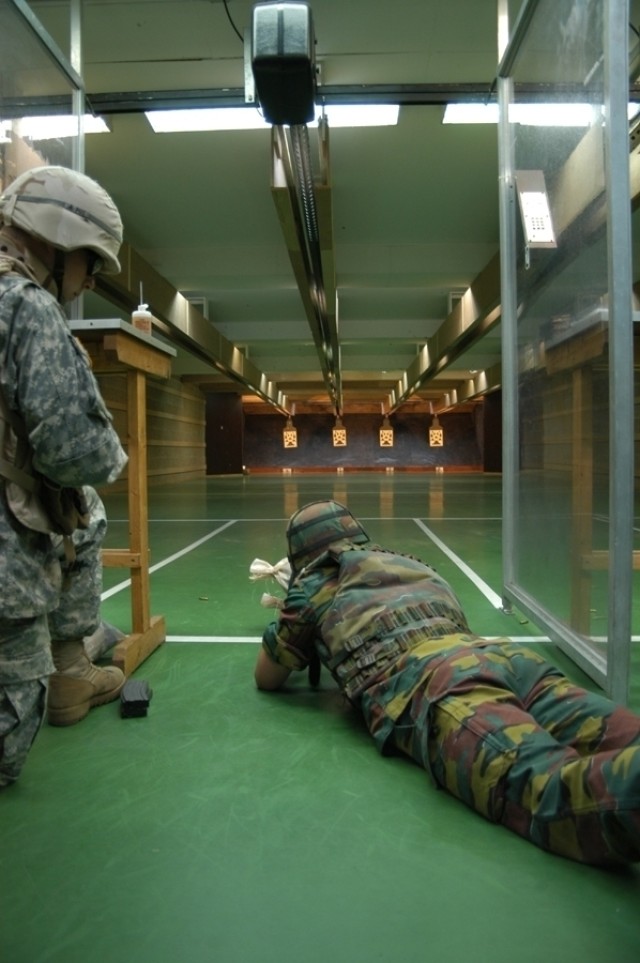CHIAfE+VRES, Belgium - The challenge of a language barrier was no obstacle for warfighters gathered at ChiAfA..vres Air Base July 23; sounds of gunfire and a direct hit signaled success to both Belgian and U.S. Soldiers.
It was that common ground that brought the Belgian Army's 1st Artillery, based out of Bastogne, and the U.S. Army Garrison Benelux together in a joint range fire exercise.
More than a dozen Belgian artillerymen, commanded by 1st Lt. Matthew De Keyzer, reported to the ChiAfA..vres Range to fire the M-16.
"This is the first time that the 1st Artillery has come here to shoot the U.S. weapon," said De Keyzer, explaining that their standard rifle is a 5.56 caliber Fabrique Nationale Carabine.
"There are differences between our nations," he said. "It is important to come here to see the U.S. environment and to manipulate their weapon."
Sgt. Joseph Daley, a Benelux military policeman, provided a hands-on, interactive demonstration of the M-16, prior to the exercise. While he claimed his French was limited to casual phrases like, "Bon Jour," his instruction was well-received as Belgian soldiers mimicked his actions.
First Sgt. Emmanuel Soquette, of the 1st Artillery, was impressed with the dual safety switches on the weapon, stating that a lock on both sides allows the range monitor to quickly observe if the weapon is secure.
Other Belgian soldiers, like 1st Soldier Yves Joine and Sgt. Jean Musoni, admired the light weight of the weapon.
One questioned the durability of the magazine, asking if it easily breaks in battle. Daley explained that it is so durable; it is probably older than he is.
Throughout the briefing, their excitement and anticipation was evident as smiles and chatter filled the room. That excitement, however, was quickly restrained as they geared up in full battle rattle and grasped the American weapon in the prone position, staring down their targets.
The Belgian soldiers performed a series of practice shots before participating in an official U.S. Army M-16 weapons qualification course.
Sgt. Michael Lynch, from the USAG Benelux Military Police, partnered with Joine on the range and said he was "very impressed" with his accuracy.
After reviewing Joine's target, Lynch, who has only been stationed in Belgium for four months, came back with thumbs up, signaling to Joine that he was doing well.
"It's cool to work with other nations," Lynch said. "It's interesting to see if their fundamentals are the same as ours."
In addition to the live fire, the Belgian soldiers experienced the virtual range at the Engagement Skills Trainer and enjoyed a lunch at the Prime Time Bar and Grill on Caserne Daumerie.
"One of our overarching goals is to build a strong partnership with the 1st Artillery," said Capt. Andy Dermanoski.
He added that the training was not only beneficial for the Belgian soldiers, but it was valuable for his Soldiers, as well.
"Dealing with international soldiers is becoming more common, as Soldiers move up in the ranks," Dermanoski said. "For my (staff sergeants), they might be working with coalition staff in the future. This will help prepare them for that."
To complete the bi-national experience, the six Belgian soldiers who qualified as marksman and the two who qualified as sharp shooters, were honored with official U.S. badges to wear on their uniforms.
Rounds of cheers and jubilation filled the room, as the awards were presented. One group of soldiers even started the wave.
Both Dermanoski and De Keyzer agreed the day was a success.
"This was a good joint effort," said De Keyzer, "The soldiers are very happy."










Social Sharing